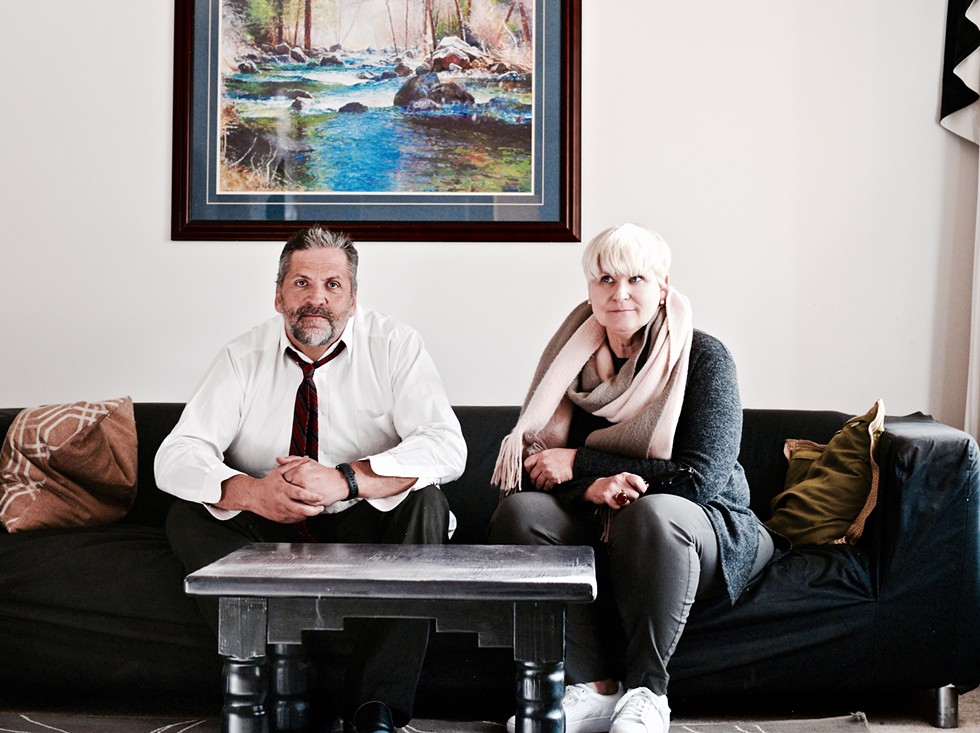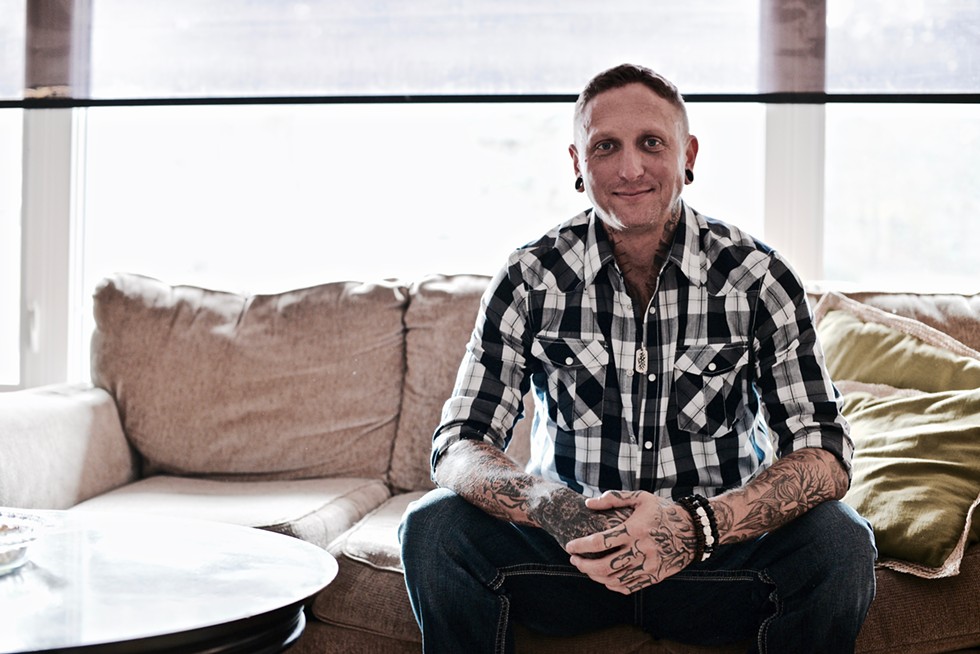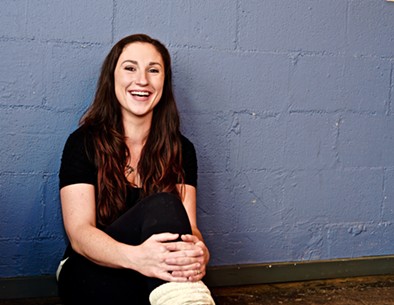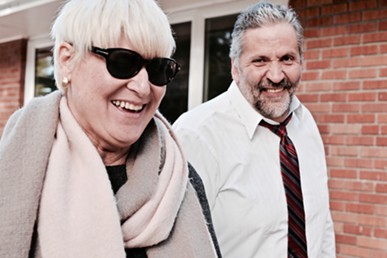
ith a less than 1 percent rental vacancy rate, it's no secret that Central Oregon is in a crippling housing crisis. For someone deemed a less than desirable tenant, with past evictions, a criminal record or substance abuse challenges, that might translate into hopelessness.
Still, there are housing-crisis success stories. Yep, you read that right.
The Scenarios
Danielle Patton has a friend who offered her Oxycontin to relax after an explosive fight with her husband. Mellowed out, Danielle stopped the pills a few days later and suffered her first of many severe physical, gut-wrenching pains. "How do I stop this?" she cried to her friend. "You have to take more," the friend replied. She defaulted to heroin, and then to meth to ease the heroin withdrawals.
"I took meth to be a super-mom. ...I felt like I worked a lot and I was tired so when I started doing meth, I felt like I could take care of my son, I could work, I could make lunches, I could make sure all of his school projects were done on time. I just felt like it gave me extra time. But in reality, it didn't. It took time away from him and pretty soon everything was about that drug."
Then there's Chip, who has chronic back pain and was prescribed painkillers. His tolerance quickly grew and his doctor cut him off suddenly. Facing painful withdrawals and expensive black-market pills, he turned to heroin. He's been clean since July and was recently released from jail.

There's Ariana who grew up with parents who met in rehab. "I used anything I could get my hands on," she says, "alcohol, pills, meth... and then came the heroin days." Arianna says one day she woke up and realized she had missed an entire month of school. At a loss and broke, she says, "There's only a few options as a non-functioning [person] to get money: steal, do sexual things, or sell drugs. I was not willing to sell myself or become a stripper, and we would just do all of the drugs. So we started robbing houses." She got caught.
And then there's Josh, who worked stressful restaurant jobs and took pills and alcohol to cope. "In a 20-year period, there were probably only 30 to 60 days total that I wasn't on something," he says. Divorce, jail, it all broke him. "People would ask, 'You're 38 years old and you don't know what you like to do for fun? What did you used to do?' And I said, I would go to bars and go do drugs in my house. That's what I did. I didn't do anything else because I had no money or time for anything else."
Though their stories are different, three common threads connect these Central Oregonians. They're all clean and sober, they've all relapsed and they all have a safe space to live because of transitional housing.
Transformation and Transition
Are you a "normie?"
That's what Gene Gammond, housing specialist and recovery mentor supervisor for Pfeifer and Associates, asks me as we tour transitional housing units in Bend. He's describing those that use—and perhaps gently abuse—substances such as caffeine, alcohol, food, cannabis or hard drugs—but don't consider themselves addicts. "They're the ones that get their first DUI and say, 'OK, something's not right, let's fix this,'" he explains. "They don't have to hit rock bottom and go to prison or lose their family before it clicks." Gammond knows this all too well—he's been in recovery for over eight years and, as he puts it, "been in and out of jail for nearly 20 years."
"Sally's a normie," laughs Gammond, referring to Sally Pfeifer, the executive director of Pfeifer and Associates, who nods in agreement as she navigates a busy intersection. She pulls up to a single-family home with a well-kept front yard and a wheelchair-accessible ramp. "It's true. I'm not in recovery," she says. "I just want to help."

Pfeifer is the executive director and founder of the largest Central Oregon drug and alcohol outpatient center, and was profiled in a recent Source Spotlight. Inside, the house is neatly decorated in '80s style, comfortable couches and all the amenities to live a clean and sober life. "There's even free coffee," a new resident proclaims, beaming brightly as he folds his laundry.
It's the little things, such as this, that make it feel like home.
Start looking for a "success story" about the housing crisis, and few will be found. The City of Bend has just given the go-ahead for 106 affordable housing units, but at the same time the Oregon Health Plan and the Affordable Health Act are hanging on by a thread, and treatment for mental illness and substance abuse—common barriers for finding housing, could be threatened by the current administration.
But there are quiet champions, and silver linings.
James Lewis, property manager for Deschutes County, referred me to Pfeifer for her work on championing for a permanent homeless camp in the county. Complicated state laws governing zoning mean a camp such as the Right to Dream Two in Portland is still far from becoming reality in Central Oregon, but since 2015, she's been taking another approach: transitional housing.
Gammond is Pfeifer's right-hand man. The two have been leasing private family homes—nearly eight in three years—and using them as transitional homes for those experiencing homelessness and in recovery.
"If you send someone to treatment for a day and they're there for a few hours, but then they return to their house with the same people they were using with in the same environment, the results are going to be the same," says Gammond as we tour the five-bedroom home. "When you send somebody to treatment and back to a place where there's people on the same paths as them, their chances of success are a lot better."
Transitional housing has been an approach since the 1970s. There's also the "Housing First" model, successfully implemented in places such as Utah and communities in Canada, that relies on the premise that those who are homeless should first be given the safety and security of shelter before addressing any underlying issues—addiction or mental health, for example. As Pfeifer puts it, "How are you supposed to battle your demons when you can't even get eight hours of uninterrupted sleep?"
Indeed, when I meet a recently-arrived male resident at a home later, he says, "Today's the first day I got to sleep in 'til 8 am, and it was great." Recently arrived from Shepard's House, a faith-based homeless shelter, he says that because he wasn't in the program, it was hard to get a good night's rest sleeping on "jailhouse mats we have to roll up by 5:30 am."
Gammond says, "I was recently talking to a gentleman who was drinking a fifth a day, and he told me, 'You would drink a fifth a day, too, if you laid your head on a rock at night.' And that made sense to me."
The transitional housing model, though, is hard to actualize. Apart from zoning, there's the stigma associated with recovery homes. "Oh, you're talking about halfway homes, right?" was a common response I received when explaining this article.

"We recently wanted to start our Bear Creek house as a homeless transitional home on the Housing First model," says Gammond, "and we brought that to the Homeless Leadership Coalition. One of the ladies on that leadership coalition wrote the homeowner, because she lived in the neighborhood. It's a classic example, really. She lived across the street from the house that we wanted to start, and she wanted to help, but she just didn't want to help enough to have it in her neighborhood. So, it didn't go through."
Stories such as these are commonplace. "I would love to dispel the myth that having a recovery house in your neighborhood is a bad thing," says Gammond, "because statistically, having these people in our house with an on-site house manager keeps the neighborhood safer than if these people were out running the streets alone with no houses with no one to pay attention to them and they're out using and doing what they do."
He continues, "We have had no arrests in our housing since opening in July of 2015. And we deal with anywhere from 145 to 152 people that are used to being in jails and prisons all the time."
Tearing Apart the Stigma
Apart from Pfeifer's homes, there is also the nationally-run Oxford House—a nonprofit, democratically run, sober housing system. A key difference is that residents of Oxford homes vote to accept new housemates. "Eighty percent must vote them in," says Gammond, "and I always wonder what happens to those people when they don't get the 80 percent vote? Where do they go and what do they do?" With their program, if you meet the 30-day sobriety test, Gammond says, "we will bring anybody in, and based on their behavior, it dictates whether they stay or not."
This system also differs in that all of them allow children. "It's everything, oh ,it's everything to have him here," says Chip, a new transitional housing resident who's been sober since July 18. His young son, Beau, sleeps gently on his lap, as Chip speaks of his long stints of relapse and jail time, having just been released Aug. 29 (their photo is the first in this article).
"One of the things that prevented me from getting better for a long time was lack of safe places to live. I've been at a tent in BLM (Bureau of Land Management), bouncing around on people's couches and once you get worse and worse in your illness you run out of couches to stay on. People just don't trust you and they don't want you around anymore."
To ensure good behavior, Pfiefer's homes employ on-site housing managers—graduates of the program, also in recovery— who, in exchange for free rent and a small stipend, make sure residents follow strict rules, clean, attend weekly house meetings and commit to living alcohol and drug free. Scheduled and random drug tests screen for seven common substances. Even Kratom, a legal stimulant, is now on the list, since some attendees have been found abusing it.
"I'm basically a mentor," says Josh Roniger, a house manager, who just celebrated four years of sobriety. "I'm at the house, I make sure the guys are on time, they keep their rooms clean, the house clean and that they're respectful to each other." Roniger has seen first-hand the impact of transitional housing. "When I first came here, there wasn't much transitional housing. I interviewed for housing five times and was going to have to go back a sixth time to get in. If Pfeifer had been around, then I would have gotten in immediately."

Past resident Danielle Patton echoes this sentiment. "You can't move into a house, with evictions on your record and tell the landlord, 'Hi, I don't have a job but I'll promise I'll get one!' Because you don't know how you're going to pay rent. But Gene (Gammond) said,'It's fine, we'll figure it out.' He let me move in. So now I'm building rental history, and paying my rent on time. It gave me an opportunity to reinvent my life."
Patton is a 27-year-old mother of two who faced a slew of possession charges and a stint in rehab before she was clean for six months. She relapsed. "I took meth to be a super-mom, but pretty quickly it consumed me. She says she tried to stay clean but, "Moved in with a friend I went to treatment with who was having a hard time staying clean. We figured if we were together it would be easier. That was not the case."
Ariana, a housing manager and graduate of the program, has been in recovery for four and a half years. She just gave up her two-bedroom apartment to move back into a Pfeifer women's home. As a housing manager, the free rent and monthly stipend will allow her to save for a down payment on a home. "I was lucky to make it to jail and not have died," she says. "So to think I could actually buy a home in two to three years, well, never did I think that could be a possibility."
A Reality: Relapse
"I tell the guys we're equal," says Roniger, the male house manager. "I try my best to keep it a communal accountability, keep everybody working towards the same goals...because we're all working towards the goal of recovery and so they kind of help each other."
Still, honor system aside, relapses do happen.
"If I hear something or if somebody is acting strange and I think there's something going on with them, I check, I do UAs, (urine analyses)... and if someone fails, they're basically given a 24-hour notice to move out. They're out for five days and then they have to pee clean to get back in," Roniger says.
"If it happens a second time, then they're out for 30 (days) or indefinitely, depending on what they do," he adds.
Gammond says the model works, "because of the rules and the structure and having that accountability piece." Transitioning from out-patient treatment to regular life can be an in-depth and painful process, so a safe and supportive space is crucial. The National Institute on Drug Abuse says transitional housing "exponentially reduces the risk of relapse," and they recommend at least 90 days of transitional sober living.
There is no real time limit on a transitional home, though Gammond says most in their program stay from six to eight months before moving on. "Not saying that everyone who walks through our doors is cured...but they don't do it while they're here.
"When we have people dying in our community who don't have a safe warm place to be, I think we have a societal issue" Gammond says. "I know people identify there's a problem and they want to do something about it, but what are they willing to do about it? Are they willing to give somebody a chance and be neighbors? It's better to try it and hopefully it works rather than not try at all and do nothing."
Editor's note: Some residents' last names have been omitted to protect their privacy.
Interns Ella Cutter and Natalie Burdsall contributed to this report.









